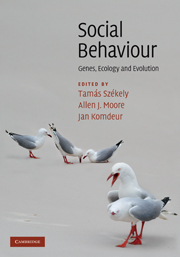Book contents
- Frontmatter
- Contents
- List of contributors
- Introduction: The uphill climb of sociobiology: towards a new synthesis
- Profile: Undiminished passion
- Part I Foundations
- 1 Nature–nurture interactions
- Profile: Social evolution, sexual intrigue and serendipity
- 2 The quantitative genetics of social behaviour
- Profile: Mating systems: integrating sexual conflict and ecology
- 3 Social behaviour and bird song from a neural and endocrine perspective
- Profile: In love with Ropalidia marginata: 34 years, and still going strong
- 4 Evolutionary game theory
- Profile: The huddler's dilemma: a cold shoulder or a warm inner glow
- 5 Recent advances in comparative methods
- Profile: Multi-component signals in ant communication
- 6 Social evolution theory: a review of methods and approaches
- Profile: What's wrong with this picture?
- Part II Themes
- Part III Implications
- Species index
- Subject index
- References
6 - Social evolution theory: a review of methods and approaches
Published online by Cambridge University Press: 05 June 2012
- Frontmatter
- Contents
- List of contributors
- Introduction: The uphill climb of sociobiology: towards a new synthesis
- Profile: Undiminished passion
- Part I Foundations
- 1 Nature–nurture interactions
- Profile: Social evolution, sexual intrigue and serendipity
- 2 The quantitative genetics of social behaviour
- Profile: Mating systems: integrating sexual conflict and ecology
- 3 Social behaviour and bird song from a neural and endocrine perspective
- Profile: In love with Ropalidia marginata: 34 years, and still going strong
- 4 Evolutionary game theory
- Profile: The huddler's dilemma: a cold shoulder or a warm inner glow
- 5 Recent advances in comparative methods
- Profile: Multi-component signals in ant communication
- 6 Social evolution theory: a review of methods and approaches
- Profile: What's wrong with this picture?
- Part II Themes
- Part III Implications
- Species index
- Subject index
- References
Summary
Overview
Over the past decades much progress has been made in understanding the evolutionary factors that can promote social behaviour. Nevertheless, the bewildering range of methods that have been employed leave many confused. Here we review some of the major approaches that can be used to model social evolution, including the neighbour-modulated fitness, inclusive fitness and multilevel selection methods. Through examples we show how these different methodologies can yield complementary insight into the evolutionary causes of social behaviour, and how, for a wide range of problems, one method can be translated into the other without affecting the final conclusion. We also review some recent developments, such as the evolution of cooperation in spatial settings and networks, and multilocus extensions of the theory, and discuss some remaining challenges in social evolution theory.
The puzzle of altruism
Individuals sometimes give up resources to benefit their neighbours, to the extent that this helping lowers the individual's reproductive fitness. Such altruistic traits (Table 6.1) pose a difficulty for Darwin's theory of natural selection, which emphasises the spread of individually advantageous traits (Darwin1859). Yet altruism abounds in the natural world, and is observed in settings as diverse as bacteria (Chapter 13), multicellular organisms with specialised non-reproductive tissues (Michod 1999, Strassmann & Queller 2007), social insects with a sterile worker caste (Bourke & Franks 1995, Ratnieks et al. 2006, Ratnieks & Wenseleers 2008), and, of course, human society (Chapter 15; Gintis et al. 2005). Thus, altruism poses a major problem for evolutionary theory.
- Type
- Chapter
- Information
- Social BehaviourGenes, Ecology and Evolution, pp. 132 - 158Publisher: Cambridge University PressPrint publication year: 2010
References
- 29
- Cited by



